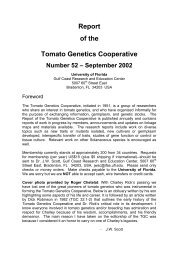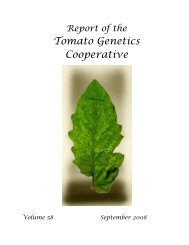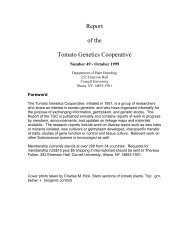Volume 60 - Tomato Genetics Cooperative - University of Florida
Volume 60 - Tomato Genetics Cooperative - University of Florida
Volume 60 - Tomato Genetics Cooperative - University of Florida
You also want an ePaper? Increase the reach of your titles
YUMPU automatically turns print PDFs into web optimized ePapers that Google loves.
flowers have smaller and lighter green petals and anthers and longer filaments (Fig 1;<br />
Petrova et al 1998). In addition to tomato nuclear male sterility mutants (reviewed in<br />
Gorman and McCormick 1997) ), similar changes <strong>of</strong> flower structures have been<br />
reported for tomato plants grown at low temperatures (Lozano et al. 1998) and in loss<strong>of</strong>-function<br />
transgenic plants for the B-class genes required for petal and stamen<br />
identity (De Martino et al. 2006).<br />
The size <strong>of</strong> plant organs is determined by cell division and cell expansion and<br />
elongation. Our investigation <strong>of</strong> the size <strong>of</strong> epidermal cells shows that the smaller size <strong>of</strong><br />
the anthers in the CMS line (Fig. 1; Stoeva-Popova et al., unpublished) can be<br />
explained largely by the reduction in the size <strong>of</strong> the cells. The epidermal cells on both<br />
surfaces <strong>of</strong> the CMS anther were significantly smaller in comparison to S. pennellii:<br />
respectively 51% smaller on the adaxial side, and 42.3% on the abaxial surface. On<br />
the other hand, no corresponding effect <strong>of</strong> cytoplasmic male sterility on cell size in the<br />
petals was observed On the abaxial surface <strong>of</strong> the petals <strong>of</strong> CMS line, the cells were<br />
81.5% larger than in S. pennellii, while on the adaxial side, they were 32.2 % smaller.<br />
According to our measurements (Stoeva et al., unpublished data) the CMS-pennellii<br />
filaments are several magnitudes longer than the filaments <strong>of</strong> S. pennellii (Fig. 1). This<br />
is not merely a consequence <strong>of</strong> increased cells size, as the filament epidermal cells <strong>of</strong><br />
CMS are statistically larger than those <strong>of</strong> S. pennellii only on the abaxial side. CMSpennellii<br />
and S. pennellii share the same nuclear genome and cytoplasmic male sterility<br />
affects expression <strong>of</strong> nuclear genes ( reviewed in Linke, Börner 2005, Chase 2006). Our<br />
results above show that cytoplasmic male sterility does not equally affect the<br />
development <strong>of</strong> petals, stamens and filaments.<br />
Our study has shown that there are significant differences in the size <strong>of</strong><br />
epidermal cells between the two species: the red-fruited cultivated tomato and the<br />
green-fruited S. pennellii. Significant differences were determined for the epidermal cells<br />
<strong>of</strong> the anthers and petals. The epidermal cells <strong>of</strong> the anthers <strong>of</strong> the cultivated tomato<br />
were larger, which is an indication that the anthers <strong>of</strong> S. pennellii have greater number<br />
<strong>of</strong> epidermal cells. The same conclusion could be drawn from the study <strong>of</strong> the abaxial<br />
epidermal cells <strong>of</strong> the petals and the filaments. Since the two species are not closely<br />
related it will be interesting to investigate other representatives <strong>of</strong> the tomato clade and<br />
to determine if the size <strong>of</strong> epidermal cells <strong>of</strong> flower structures can be indicative <strong>of</strong><br />
species relatedness.<br />
Although no statistical analysis was carried out, our data show one consistent<br />
feature across all genotypes: the largest epidermal cells were observed on anthers,<br />
while the ones with the smallest surface area were epidermal cells <strong>of</strong> petals.<br />
<strong>60</strong>





